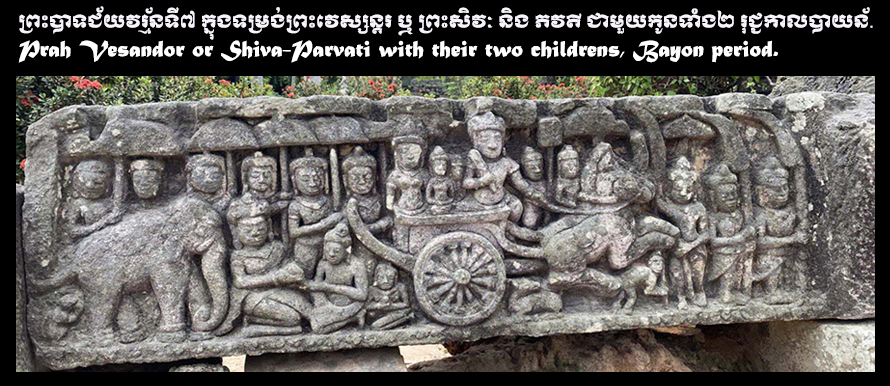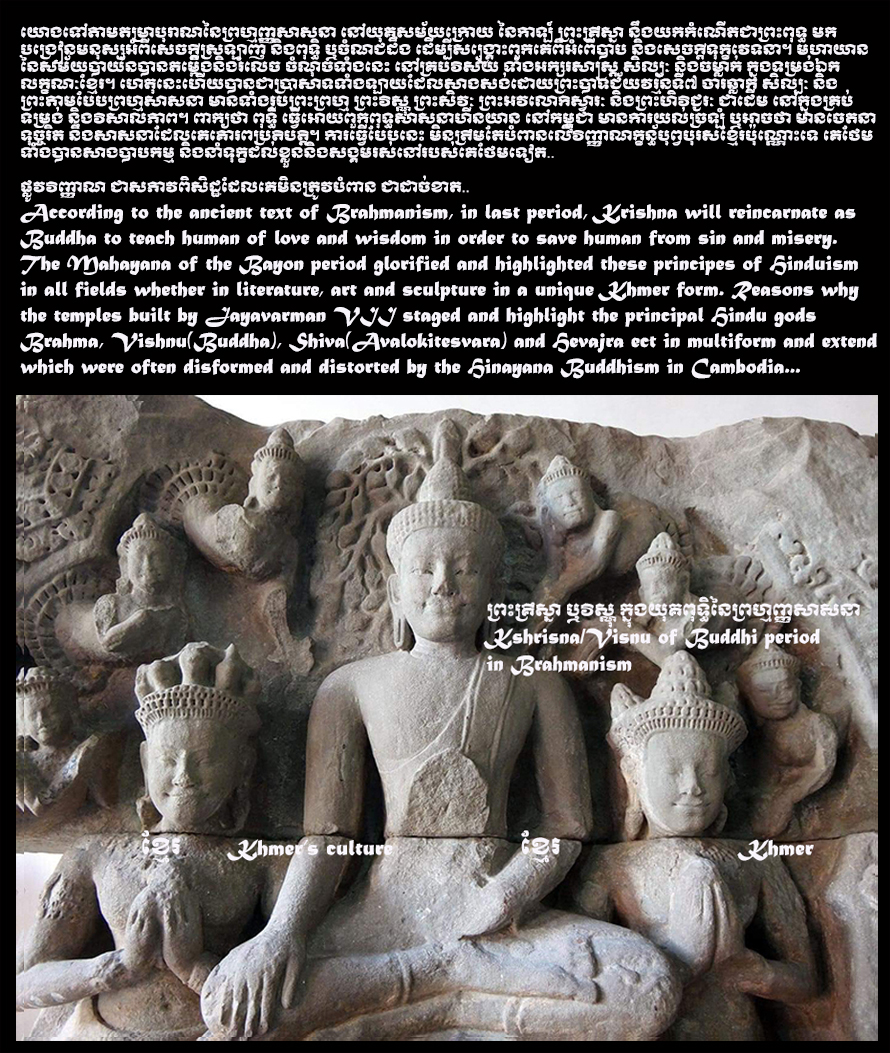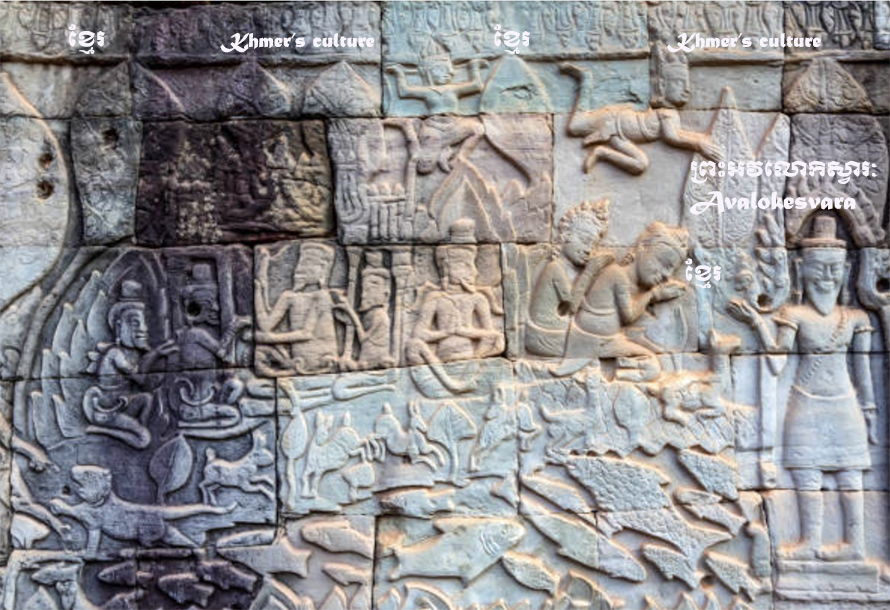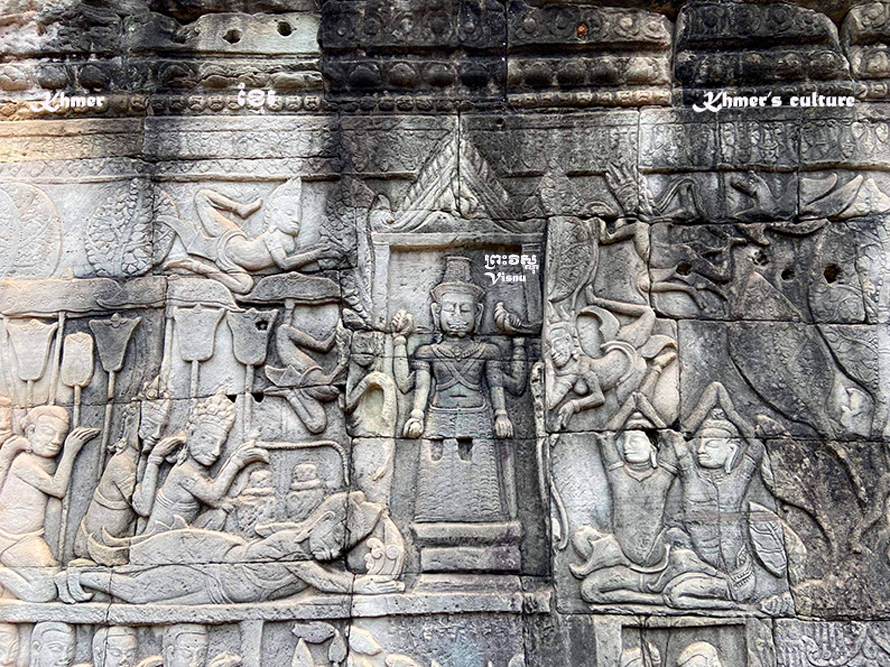រូបទី១៖ ផ្ទាំងធ្នឹមខាងក្រោមបង្ហាញអំពីព្រះបាទជ័យវរ្ម័នទី៧ ធ្វើដំណើរតាមរទេះសេះជាមួយភរិយា និងកូនពីរនាក់។ ផ្ទាំងទស្សនីភាពនេះ ត្រូវបានខ្មែរសម័យក្រោយអង្គរយកទៅធ្វើជាគំរួ ក្នុងស្ត្រារាមកេរ្ត៍ វេស្សន្តរ នាសតវត្សរ៍ទី ១៦-១៩ ដែលបង្ហាញពីព្រះវេស្សន្តរបានចាកចេញ ពីនគរ របស់ទ្រង់ដើម្បីទៅធ្វើតាបសក្នុងព្រៃជ្រៅ។ រូបចន្លាក់ក្នុងបរិបទបែបនេះ ក៏ត្រូវបានបន្សល់ទុកពីសម័យបាភួន ផងដែរ តែតួអង្គផ្សាយមេត្តាធម៌នៃសម័យ បាភួន គឺជាតួង្គព្រះសិវៈ។ Pra Vesanthor យោងទៅតាមទេវកថានៃព្រះពុទ្ធសាសនា Hinayana គឺជាតួអង្គនៃជីវិត ចុងក្រោយរបស់ Gautama មុនពេលក្លាយជាព្រះពុទ្ធ។ តាមជំនឿខ្មែរ និងពុទ្ធនិកហីនយាន នៅអាស៊ីអគ្នេយ៍ ទេវកថា ពីជីវិតរបស់ គោតមសិទ្ធត្ថ មានទាំងអស់ចំនួន 500 ជាតិ ប៉ុន្តែ មានតែកំណើតដប់ចុងក្រោយប៉ុណ្ណោះរបស់គោតមសិទ្ធត្ថ ប៉ុណ្ណោះដែលជាជាតិតក សំខាន់បំផុត ដែលគេហៅថា Tuos cheatdok ។ បើយោងទៅតាមភស្តុតាងផ្សេងៗ រួមទាំងចម្លាក់ជា ច្រើនដែលបានបន្សល់ទុក និង ភាពល្បីល្បាយរីកចម្រើន នៃចក្រភពខ្មែរ ជាពិសេស ការជឿនលឿននៃអក្សរសិល្ប៍សម័យអង្គរ និងបាយ័ន យើងអាចកំណត់ដោយ សត្យានុម័តថា ពួកពុទ្ធសាសនាហីនយាននៅកម្ពុជា បានកែក្រឡៃទេវកថា ឬអក្សរសិល្ប៍សាសនានៃ សាសនាហិណ្ឌូ របស់ខ្មែរ អោយក្លាយ ជាហីនយាន ដោយបានប្រើតួអង្គ គោតមសិទ្ធត្ថ មកជំនួស ទេវៈបុរាណរបស់ខ្មែរ មាន ព្រះព្រហ្ម ព្រះវិស្ណុ ព្រះសិវៈ ។ល។ យើងអាចដឹង បានដោយ ទេវកថាហីនយានបែបនេះ មានតែនៅកម្ពុជា និងតំបន់ក្រោមឥទ្ធិពល ខ្មែរប៉ុណ្ណោះ។ ទេវកថា ឬអក្សរសិល្ប៍សាសនាបែបនេះ មិនមាននៅក្នុងស្ត្រាដើមរបស់ក្រុមពុទ្ធសាសនាហីនយាននៃស្រីល្លង្កានោះទេ ថែមទាំងបាន បដិសេដថា វាមិនមែនជាការបង្រៀន របស់គោតមសិទ្ធិត្ថនោះទេ។ គួរបញ្ជាក់ដែរថា នៅចន្លោះសតវត្សទី១៥ ដល់ដើម សតវត្សទី១៦ ក្រោមរជ្ជកាលព្រះបាទអង្គច័ន្ទរាជា ទីក្រុងអង្គរត្រូវក្រុមពុទ្ធសាសនិកជនហីនយាន កែប្រែឱយក្លាយជាមជ្ឈមណ្ឌលសាសនាហីនយានដ៏ធំ ដើម្បីផ្សព្វផ្សាយសាសនាហីនយាន ក្នុងតំបន់ទាំងមូល។ អង្គចន្ទរាជា បានសាងសង់ពុទ្ធបដិមាចំនួន ១០០០អង្គ ហើយបានយកទៅ តម្កល់នៅគ្រប់ទីកន្លែងក្នុង និងជុំវិញប្រាសាទខ្មែរនានានៃតំបន់អង្គរ។ ចំណេរតមក រូបសំណាកទាំងនេះខ្លះត្រូវបានបំផ្លាញដោយ ពួកចោរមកពីប្រទេសជិតខាង ខ្លះត្រូវកប់ទៅក្នុងដី មួយចំនួនដែលនៅសេសសល់ក៏មានភាពទ្រុតទ្រមបែកបាក់។ គឺនៅក្រោម រជ្ជកាលរបស់ទ្រង់ដដែល ដែលបដិមាព្រះពុទ្ធបដិមាមួយអង្គធំ ក្នុងឥរិយាបទ ចូលនិពាន្វ ត្រូវបានសាងសង់ឡើងពីបំណែកប្រាសាទ បាភួន ដែលបាក់បែកដោយ ពួកចោរមកពីប្រទេសជិតខាង ដែលបានចូលមកប្លន់ និងបំផ្លាញរាជធានីអង្គរ ចន្លោះសតវត្សទី ១៤ និងទី ១៥ ។
Figure 1: Lintel below shows Jayavarman VII traveling in a chariot with his wife and two children. This image was used by the post-Angkorian Khmer as a model in the manuscript relating the Khmer Ramayana and Vedansor buddhist version of 16th and 19th centuries, showing Vesna leaving his kingdom to practice asceticism in the deep forest (Lanka, Kurushetra battle, Angkor, Inde). Pra Vesanthor, according to Hinayana Buddhist myth, is the personage of Gautama in his last life before becoming Buddha. According to the beliefs of the Khmer Hinayanas as in Southeast Asia, the myths about Gautama's life totaled 500 reincarnations, but only the last ten births of Gautama were considered to be the most important called Tuos cheatdok. Based on numerous evidences, including countless sculptures, stories, and inscriptions left by the Angkorians, mentioning the remarkable progress of Angkorian and Bayon literature, we can legitimately assumed that Hinayana Buddhism in Cambodia distorted the myths of Hindu religious literature of the Angkorians to transform them into Hinayana religious literature by replacing Gautama Buddha at the center at the place of the Khmer Ancient belief and Gods, Brahma Vishnu, Shiva, etc.
Such myths or religious literature do not exist in the original Hinayana Buddhism of Sri Lanka, though even rejecting that it is the teaching of Gautama. It is worth to note that between the 15th and early 16th centuries, under the reign of King Ang Chan Reachea, Angkor was transformed into a major Hinayana Buddhist center in SEA to spread Hinayana Buddhism throughout the region. Ang Chan Reach has built 1,000 Buddha statues and had placed in and around the Khmer temples of Angkor. Some of these statues were destroyed by the robbers from neighboring countries, others were buried and the rest are in ruins. It was also during his reign that a large sleeping Buddha statue was built from the fragments of the Baphuon temple, destroyed by thieves from neighboring countries who came to plunder and destroy the capital of Angkor during the 14th and 15th centuries.
|







